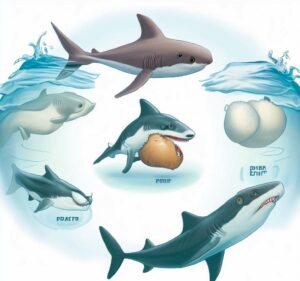Key Takeaways
- The life cycle of a great white shark consists of several distinct stages, including birth, growth, reproduction, and death.
- Great white sharks are ovoviviparous, meaning that the eggs develop and hatch inside the mother’s body before she gives birth to live young.
- The gestation period for great white sharks can last up to 18 months, making it one of the longest among all shark species.
- Juvenile great white sharks spend their early years in coastal areas, feeding on smaller fish and marine mammals.
- As they grow, great white sharks start to venture into deeper waters and expand their diet to include larger prey such as seals and sea lions.
- Female great white sharks reach sexual maturity around the age of 12-14 years, while males mature slightly earlier at around 9-10 years.
- Great white sharks have a low reproductive rate, with females typically giving birth to only 2-10 pups every few years.
- The average lifespan of a great white shark is estimated to be around 30-40 years, although some individuals have been known to live longer.
- Despite their fearsome reputation, great white sharks play a crucial role in maintaining the balance of marine ecosystems as top predators.
- Understanding the life cycle of great white sharks is essential for their conservation and management, as it helps scientists identify critical habitats and implement effective protection measures.
Great White Sharks – some of the ocean’s most powerful predators – have an incredible life cycle. With sleek bodies, sharp teeth, and lightning-fast speed, they are truly remarkable creatures.
They are ovoviviparous, which means their young develop inside eggs that hatch within the mother’s body. So female sharks give birth to live offspring. This protects and nourishes them until they can survive in open water.
Young Great Whites stay in shallow coastal waters with plenty of food. They hone their hunting skills on smaller fish and marine mammals. This is when they start to grow their iconic size and strength.

It takes several years for these juvenile sharks to become sexually mature and head into deeper waters. Here they become solitary hunters, crossing long distances in search of food. With a strong sense of smell and acute hearing, adult Great Whites are formidable and adaptable creatures.
Did you know? Research shows South African Great Whites travel 12,000 miles from South Africa to Australia and back in just one year – an amazing navigational skill!
The life cycle of a Great White Shark is awe-inspiring. From birth to adulthood, they go through amazing changes in both their physical and behavior. Knowing about this shows us why we must protect these apex predators and their habitats for future generations.
Basic Information about Great White Sharks
Great White Sharks are extraordinary creatures famed for their striking appearance and powerful presence. They have sleek bodies, razor-sharp teeth, and can grow up to 20 feet in length and 4,000 pounds, making them one of the world’s largest predatory fish. Their white underbellies and gray upper bodies grant them camouflage in the ocean depths.
These apex predators hunt with a special technique – surprise attacks from below. With great agility and speed, they breach the water’s surface to catch seals, sea lions, and other marine mammals unawares. Their strength allows them to take down much larger prey with ease.

Not only are they impressive hunters, Great White Sharks have a unique life cycle. They are viviparous, meaning that their eggs hatch inside the female’s body rather than externally. The gestation period can last up to a year or more before giving birth to live young.
It is intriguing to learn that these majestic creatures can live for decades. However, determining their exact lifespan is a challenge due to limited scientific research and observation capabilities. The oldest recorded Great White Shark was estimated to be around 73 years old.
Life Cycle of Great White Sharks
The life cycle of Great White Sharks is a remarkable thing! They have multiple stages, each being essential for their development and survival. See below for info:
| Stage | Description |
| Birth | Hatch from eggs inside the mother’s uterus after a 12 month gestation period. |
| Pup | Young Great Whites are called pups and measure 5 feet at birth. |
| Juvenile | As they get older, juveniles start to explore and learn how to hunt. |
| Adult | Fully grown Great Whites reach an average of 15 feet and are formidable hunters. |
These predators also have other remarkable features. They can adjust to different environments, living for 30-70 years. Plus, researchers discovered an incredibly huge female shark called Deep Blue – estimated to be 20 feet long and weighing 2 tons. This proves that while they may look frightening, they keep the ocean in balance.

So, the life cycle of Great White Sharks is something to behold! From tiny pups to huge adults, these creatures show us the wonders in the depths. Watch out, fish! You’re about to find out who’s boss.
Feeding Habits and Hunting Techniques of Great White Shark
The Feeding Habits and Hunting Techniques of the Great White Shark
The great white shark is a skilled hunter that exhibits precision, power, and adaptability. Its unique strategies help it secure prey in different environments. It relies on its keen sense of smell to detect even faint traces of blood from miles away. Then, it launches itself with an explosive burst known as a “breach attack” to surprise and overwhelm its victim.
Furthermore, its powerful jaws and razor-sharp teeth deliver devastating blows with a single bite force of 4,000 psi. The shape of its teeth is designed for gripping and tearing flesh. Depending on their location, great white sharks consume marine mammals such as seals or sea lions, or fish species like tuna or mackerel.
Spy-hopping is another behavior observed in great white sharks. They raise their heads above water level to survey their surroundings and spot prey from greater distances. Female sharks have also been seen migrating between feeding grounds and nursery areas. This suggests they plan their movements carefully to ensure successful reproduction and prey availability.
Research by marine biologists and shark experts worldwide has greatly contributed to our understanding of the great white shark’s feeding habits and hunting techniques.
Great White Shark Migration Patterns
Great white sharks are renowned for their fascinating migration patterns. They travel thousands of miles across the ocean, between feeding and breeding grounds. These incredible creatures have amazing navigational capabilities, using cues like magnetic fields and ocean currents to guide them.
Migrations are essential for maintaining the genetic diversity and ecological balance of the species. An example is “Nicole”, who traveled an impressive 12,400 miles from South Africa to Australia. Such resilience and capability are remarkable and a reminder of their majestic nature. Sadly, their lives aren’t easy, but fortunately they don’t need to worry about needing a personal trainer to stay fit!
Threats to Great White Shark and Conservation Efforts
Great White Sharks face danger! We must protect them. This includes implementing sustainable fishing practices, creating marine protected areas, monitoring climate change impacts, enforcing laws to stop illegal hunting & trading, and educating people about their importance.
These sharks have unique characteristics that make them vulnerable. They reproduce slowly and mature late. So, conservation efforts are even more essential.
Recently, the world is getting more aware of the need to protect Great White Sharks. International cooperation & initiatives are helping with this.
We must remember that our actions affect the ocean’s balance. By implementing effective conservation strategies, we can save Great White Sharks and our planet’s marine ecosystems!
Frequently Asked Questions
1. What is the life cycle of a great white shark?
The life cycle of a great white shark consists of three main stages: birth, juvenile, and adult.
2. How long does it take for a great white shark to reach adulthood?
It typically takes about 10 to 15 years for a great white shark to reach adulthood.
3. Where do great white sharks give birth?
Great white sharks give birth to live young in nurseries located in shallow coastal waters.
4. What do great white shark babies eat?
Great white shark babies, known as pups, feed on smaller marine animals such as fish and rays.
5. How long do great white sharks live?
The average lifespan of a great white shark is estimated to be around 30 to 40 years, but some individuals have been known to live up to 70 years.
6. Are great white sharks endangered?
Great white sharks are currently listed as vulnerable according to the International Union for Conservation of Nature (IUCN). Populations have declined due to overfishing and habitat degradation.
Conclusion
The Great White Shark has a unique life cycle. As pups, they must use their instinctual hunting skills to survive. As they age, they become larger and stronger. This enables them to hunt larger prey.
Their reproductive habits are remarkable. Females can store sperm from previous mating encounters. And their gestation period can last up to 18 months – one of the longest among all shark species!
Astonishingly, this apex predator has been recorded diving to depths of over 4,000 feet (1,220 meters). This was documented by researchers from Stanford University. They used electronic tagging devices to monitor the shark’s movements.
Reference:




